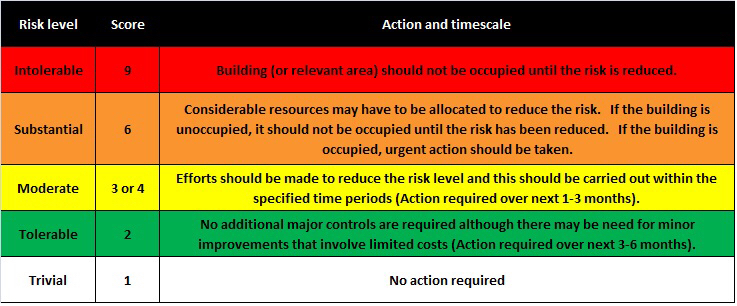Information
-
Name of Premises
-
Add media
-
Address of Premises
-
Date of fire risk assessment
-
Assessor
Cover Sheet
-
The purpose of this report is to provide an assessment of the risk to life from fire in these premises, and, where appropriate, to make recommendations to ensure compliance with fire safety legislation.
The report does not address the risk to property or business continuity from fire.
I certify that to the best of my knowledge, the information contained in this fire risk assessment is correct, based on information provided at the time the assessment was undertaken. -
Responsible person or person having control of the premises:
-
Competent Person(s):
-
Person(s) consulted:
-
Date of previous fire risk assessment:
-
Suggested date for review of fire risk assessment:
-
This fire risk assessment should be reviewed by a competent person by the date indicated above or at such earlier time as there is reason to suspect that it is no longer valid, or there has been significant change in the matters to which it relates, or if a fire occurs.
General Building Description
SECTION 1 - THE PREMISES
-
1.1 - Number of floors (including basement):
-
1.2 - Approximate floor area (in square metres):
-
1.3 - Brief details of building construction:
-
1.4 - Use of premises:
SECTION 2 - THE OCCUPANTS
-
2.1 - Approximate maximum number of employees at any one time:
-
2.2 - Approximate maximum number of members of the public at any one time:
-
2.3 - Approximate maximum number of persons:
-
2.4 - Associated times/hours of occupation:
SECTION 3 - OCCUPANTS AT SPECIAL RISK FROM FIRE
-
3.1 - Sleeping occupants?
-
3.2 - Disabled occupants?
-
3.3 - Occupants in remote areas and Lone Workers?
-
3.4 - Young Persons?
-
3.5 - Others?
SECTION 4 - FIRE LOSS EXPERIENCE
-
4.1 - Fires in the past 10 years?
-
4.2 - Cost of fire losses (in pounds)?
SECTION 5 - OTHER RELEVANT INFORMATION
-
Recommended Fire Evacuation Procedure
-
This means that the building is designed to contain a fire in the compartment in which it starts. If a fire starts in another part of the building occupants may stay in their flats/apartments . If smoke begins to affect their dwelling then they must evacuate then building immediately. This procedure may only be adopted as long as the building along with and fire safety components and systems remain well maintained, serviced and fully functional.
-
Other Relevant Information.
SECTION 6 - RELEVANT FIRE SAFETY LEGISLATION
-
6.1 - The following fire safety legislation applies to these premises: Regulatory Reform (Fire Safety) Order 2005.
-
6.2 - The above legislation is enforced by the relevant Fire & Rescue Service
-
6.3 - Other legislation that makes significant requirements for fire precautions in these premises (other than the Building Regulation 2010):
-
6.4 - The legislation to which 6.3 makes reference is enforced by:
Fire Hazards
SECTION 7 - ELECTRICAL SOURCES OF IGNITION
-
7.1 - Reasonable measures taken to prevent fires of electrical origin?
-
7.2 - Fixed wiring installation periodically inspected and tested?
-
7.3 - Portable appliance testing (where appropriate) carried out?
-
7.4 - Suitable policy regarding the use of personal electrical appliances?
-
7.5 - Suitable limitation of trailing leads and adapters?
SECTION 8 - SMOKING
-
8.1 - Reasonable measures taken to prevent fires as a result of smoking?
-
8.2 - Smoking prohibited on the premises?
-
8.4 - Suitable arrangements for those who wish to smoke?
-
8.5 - Does the no smoking policy appear to be observed at time of inspection?
SECTION 9 - ARSON
-
9.1 - Does basic security against arson by outsiders appear reasonable?
-
9.2 - Is there an absence of unnecessary fire load in close proximity to the premises or available for ignition by outsiders?
SECTION 10 - PORTABLE HEATERS AND HEATING INSTALLATIONS
-
10.1 - Is the use of portable heaters avoided as far as practicable?
-
10.2 - If portable heaters are used, is the use of the more hazardous type (e.g. radiant bar fires or lpg appliances) avoided?
-
10.3 - If portable heaters are used are suitable measures taken to minimise the hazard of ignition of combustible materials?
-
10.4 - Are fixed heating installations subject to regular maintenance?
SECTION 11 - COOKING
-
11.1 - Are reasonable measures taken to prevent fires as a result of cooking?
-
11.2 - Are filters changed and ductwork cleaned regularly?
-
11.3 - Are suitable extinguishing appliances available?
SECTION 12 - LIGHTNING PROTECTION
-
12.1 - Do the premises have a lightning protection system?
-
12.2 - Has the Lightning protection system been serviced?
SECTION 13 - OTHER SIGNIFICANT IGNITION SOURCES
-
13.1 - Are there other significant ignition sources present?
-
undefined
-
13.3 - Are there light bulbs or heating appliances near flammable/combustible materials?
SECTION 14 - HOUSEKEEPING
-
14.1 - Is the standard of housekeeping adequate?
-
14.2 - Are combustible materials separated from ignition sources?
-
14.3 - Is there an avoidance of unnecessary accumulation of combustible materials or waste?
-
14.4 - Is there appropriate storage of combustible materials?
-
14.6 - Are all textiles and furniture treated to be fire retardant?
-
14.7 - Are substantial areas of wall or ceilings covered with flammable linings or materials?
SECTION 15 - OUTSIDE CONTRACTORS AND BUILDING WORKS HAZARDS
-
15.1 - Are fire safety conditions imposed on outside contractors?
-
15.2 - Is there satisfactory control over works carried out on the premises by outside contractors (including "hot work" permits)?
-
15.3 - If there are in-house maintenance personnel, are suitable precautions taken during "hot work", including use of "hot work" permits
SECTION 16 - DANGEROUS SUBSTANCES
-
16.1 - Have the hazardous properties of dangerous substances been considered?
-
16.2 - Is there adequate information on safety provided by the supplier on any relevant safety data sheet?
-
16.3 - Has account taken place regarding:
-
16.3.1 - The special, technical and organisational measures and substances used and their possible integrations?
-
16.3.2 - The amount of the substances involved?
-
16.3.3 - Where the work will involve more than one dangerous substance, the risk presented by such substances in combination?
-
16.3.4 - The arrangements for the safe handling, storage and transport of dangerous substances and of waste containing dangerous substances?
-
16.3.5 - Any other measures introduced as a result of the RRO/FRA.
-
16.4 - Are there safe systems of work for maintenance, where there is a potential for a high level of risk?
-
16.5 - Are sufficient control measures in place to counter the likelihood that an explosive atmosphere will occur and its persistence including adjacent areas?
-
16.6 - Are sufficient control measures in place to counter the likelihood that ignition sources, including electrostatic discharges, will be present and become active and effective?
-
16.7 - Has account been taken regarding the scale of the anticipated effects?
-
16.8 - Is sufficient additional safety information available to enable the assessment to be completed?
-
16.9 - Has account been taken regarding sources of oxygen?
-
16.9.1 - Is there piped oxygen in use?
-
16.9.2 - Are there oxygen cylinders used or stored?
-
16.9.3 - Is there an operational procedure for isolation?
-
16.9.4 - Are oxidising materials used or stored?
-
16.10 - Has a specific risk assessment been carried out, as required by the Dangerous Substances and Explosive Atmospheres Regulations 2002?
-
16.11 - Are there other significant hazards that warrant consideration including process hazards that impact on general fire precautions?
Fire Protection
SECTION 17 - MEANS OF ESCAPE
-
17.1 - It is considered that the premises are provided with reasonable means of escape in case of fire?
-
17.7 - Are there satisfactory means for securing exits?
-
17.2 - Is there adequate design of escape routes?
-
17.3 - Is there adequate provision of escape exits?
-
17.4 - Are exits easily and immediately openable where necessary?
-
17.5 - Do fire exits open in direction of escape where necessary?
-
17.6 - Are sliding or revolving doors avoided as fire exits where necessary?
-
17.8 - Are travel distances reasonable where there is a single direction of travel?
-
17.9 - Are alternative means of escape travel distances reasonable?
-
17.10 - Is there suitable protection of escape routes?
-
17.11 - Are suitable fire precautions provided for all inner rooms and inner inner rooms?
-
17.12 - Are all escape routes unobstructed?
-
17.13 - Is the premises provided with reasonable arrangements for means of escape for disabled people?
-
17.14 - Are the exits in the right place and do the escape routes lead as directly as possible to a place of total safety?
-
17.15 - Are the people who work in the building aware of the importance of maintaining the safety of the escape routes by ensuring that fire doors are not wedged or held open?
-
17.16 - Are fire doors holed or damaged, do the gaps between door and frame exceed 3mm or between door and floor exceed 3mm (smoke) 10mm (Fire only)?
-
17.17 - Are fire doors provided with appropriate fire door signs?
-
17.18 - Are all external escape routes unobstructed and providing a clear route to the fire assembly points?
-
17.19 - Are any holes or gaps in walls, ceilings and floors properly sealed, e.g. where services such as ventilation ducts and electrical cables pass through them?
-
17.20 - Can all the occupants escape to a place of absolute safety in a reasonable time?
-
17.21 - Are fire assembly points in safe locations fit for purpose?
-
17.22 - Is fire door integrity/strips/seals and all door furniture adequately maintained?
-
17.23 - Are fire action notices adequate?
-
17.24 - Are high risk rooms adequately protected?
-
17.25 - If vertical evacuation is necessary (internal or external), are stairways suitable in size and width?
SECTION 18 - FIRE SPREAD AND DEVELOPMENT LIMITATION
-
18.1 - It is considered that there is compartmentation of a reasonable standard
-
18.2 - It is considered that there is reasonable limitation of linings that might promote fire spread
-
18.3 - If provided, are sprinklers of the correct type for the risks present?
-
18.4 - Are fire/smoke dampers and control systems maintained and tested?
SECTION 19 - EMERGENCY ESCAPE LIGHTING
-
19.1 - Are all your escapes covered by an acceptable form of emergency lighting?
-
19.2 - Are toilets, plant rooms, external fire escape staircases, underground car parks and external escape routes covered by an acceptable form of emergency lighting?
-
19.3 - Is there back-up power supplies for the emergency lighting?
SECTION 20 - FIRE SAFETY SIGNS AND NOTICES
-
20.1 - Where necessary are escape routes and exits, the locations of fire fighting equipment and emergency telephones indicated by appropriate signs?
-
20.2 - Where necessary are notices provided such as those giving information on how to operate security devices on exit doors, those indicating doors enclosing fire hazards that must be kept shut and fire action notices for staff and other people?
-
20.3 - Are you maintaining all the necessary sign and notices so that they continue to be correct, legible and understood?
-
20.4 - Are you maintaining signs that you have provided for the information of the fire and rescue service, such as those indicating the location of water suppression stop valves and the storage of hazardous substances?
SECTION 21 - FIRE WARNING ARRANGEMENTS
-
21.1 - Is a there a fire alarm system provided?
-
21.2 - Are fire alarm call points located at all final exits, story exits, fire compartment wall exits or exits from rooms of high risk?
-
21.3 - Is the fire panel located at an exit and visible to the emergency services from the outside of the building?
-
21.4 - Can the existing means of detection ensure a fire is discovered quickly enough for the alarm to be raised in time for all the occupants to escape to a place of total safety?
-
21.5 - Are the automatic fire detectors of the right type and in the appropriate locations?
-
21.6 - Can the means of warning be clearly heard or be perceptible and understood by everyone throughout the whole building when initiated from a single point?
-
21.7 - Are there provisions for people in locations where the alarm cannot be heard?
-
21.8 - If the fire-detection and warning system is electrically powered, does it have a back-up power supply?
-
21.9 - Is there a remote transmission of alarm signal?
-
21.10 - Is a zone plan of the fire alarm system provided adjacent to the main control panel?
SECTION 22 - PORTABLE FIRE EXTINGUISHING APPLIANCES
-
22.1 - Are the extinguishers suitable for the purpose?
-
22.2 - Are there enough extinguishers sited throughout the premises at appropriate locations?
-
22.3 - Are the right type of extinguishers located close to the fire hazards and can users get to them without exposing themselves to risk?
-
22.4 - Are the extinguishers hidden from view and their position need indicating?
-
22.5 - Have steps been taken to prevent the misuse of extinguishers?
-
22.6 - Are fire fighting appliances checked that they are in good order at least monthly by the occupier?
-
22.7 - Are those that test and maintain the fire fighting equipment competent to do so?
SECTION 23 - AUTOMATIC FIRE EXTINGUISHING SYSTEMS
-
23.1 - Is there a suitable sprinkler or water based system that is adequate for the risk present?
-
23.2 - Is there a suitable gaseous local application of total flooding provided that is adequate for the risk?
-
23.3 - Are those who test and maintain the fixed fire fighting systems competent to do so?
SECTION 24 - OTHER RELEVANT FIXED SYSTEMS AND EQUIPMENT
-
24.1 - Are there suitable smoke control facilities for the risk present?
-
24.2 - Are those who test and maintain the smoke control facilities competent to do so?
SECTION 25 - LUMINOUS DISCHARGE TUBES
-
25.1 - Has notice been given to the fire and rescue authority regarding luminous discharge tubes (neon signs) cut-off switch, it's colouring and marking?
Managing Fire Safety
SECTION 26 - PROCEDURES AND ARRANGEMENTS
-
26.1 - Appropriate fire procedures in place and properly documented?
-
26.2 - Are staff aware of the emergency plan, including the identity of people nominated to do a particular fire duty?
-
26.3 - Have visitors and guests been informed about what to do in an emergency?
-
26.4 - Have staff been given information about any dangerous substances?
-
26.5 - Do you have arrangements for informing temporary or agency staff?
-
26.6 - Is there an arrangement for informing other employers whose staff are guest workers in your premises, such as maintenance contractors and cleaners?
-
26.7 - Have fire safety arrangements been co-ordinated with other responsible people and with any contractors in the building?
-
26.8 - Have details been recorded of any information or instructions you have been given and the details of any arrangements for co-operation and co-ordination with others?
-
26.9 - Has a fire safety manager/deputy fire safety manager been appointed in writing with a suitable job description?
-
26.10 - Have sufficient fire wardens been appointed to help in evacuating the premises?
-
26.11 - Are there suitable arrangements for summoning the fire and rescue services?
-
26.12 - Are there suitable arrangements to meet the fire and rescue service on arrival and provide them with relevant information?
-
26.13 - Are there suitable arrangements for ensuring that the premises have been evacuated?
-
26.14 - Is there a suitable fire assembly point(s)?
-
26.15 - Are there adequate procedures for evacuation of any disabled people who are likely to be present?
-
26.16 - Are persons nominated and trained to use fire extinguishing appliances?
-
26.17 - Are persons nominated and trained to assist with evacuation of disabled people?
-
26.18 - Have the fire and rescue service carried out pre-fire inspections of the premises?
-
26.19 - Has an emergency pack been provided for fire and rescue service information during an incident?
-
26.20 - Are routine fire inspections carried out?
SECTION 27 - TRAINING AND DRILLS
-
27.1 - Are all staff given adequate fire safety instruction and training on induction?
-
27.2 - Are all staff given periodic "refresher training" at suitable intervals
-
27.3 - Are regular fire drills carried out at appropriate intervals?
-
27.4 - Does all staff training provide information, instruction or training on the following:
-
27.4.1 - Fire risks in the premises?
-
27.4.2 - The fire safety measures on the premises?
-
27.4.3 - Action in case of fire?
-
27.4.4 - Action on hearing the fire alarm?
-
27.4.5 - Method of operation of fire alarm call points?
-
27.4.6 - Location and use of fire extinguishers?
-
27.4.7 - Means of summoning the fire and rescue service?
-
27.4.8 - Identity of the persons nominated to assist with evacuation?
-
27.4.9 - Identity of persons nominated to use fire extinguishing appliances?
-
27.5 - Are fire wardens given additional training?
-
27.6 - Are joint training and fire drills sessions carried out in multi-occupied buildings?
-
27.7 - Are employers aware of fire risks and general fire precautions for organisations in the premises?
-
27.8 - Are employees provided with adequate instruction and information regarding fire risks and general fire precautions for other organisations in the premises?
-
27.9 - Have staff working in areas used to store hazardous or explosive substances had appropriate fire training?
-
27.10 - Has the fire manager/deputy fire manager had appropriate training for their role?
-
27.11 - Are appropriate training measures in place for those workers with language difficulties?
SECTION 28 - TESTING AND MAINTENANCE
-
28.1 - Adequate maintenance of premises?
-
28.2 - Weekly testing and periodic servicing of fire detection and alarm system?
-
28.3 - Monthly and annual testing routines for emergency lighting?
-
28.4 - Annual maintenance of fire extinguishing appliances?
-
28.5 - Weekly testing and periodic inspection of sprinkler installations?
-
28.6 - Six-monthly inspection and annual testing of rising mains?
-
28.7 - Weekly and monthly testing, six-monthly inspection and annual testing of fire-fighting lifts?
-
28.8 - Periodic inspection of external escape staircase and gangways?
-
28.9 - Routine checks of final exit doors and/or security fastenings?
-
28.10 - Annual inspection and test of lightning protection system
-
28.11 - Six-monthly inspection and annual testing of private hydrants?
-
28.12 - Other relevant inspections or tests carried out:
-
28.13 - Do you carry out daily checks to ensure that there is clear access to fire engines?
-
28.14 - Are suitable systems in place for reporting and subsequent restoration of fire safety measures that have failed?
SECTION 29 - RECORDS
-
29.1 - Are appropriate records kept for fire training and fire evacuation drills?
-
29.2 - Are appropriate records kept for fire alarm tests?
-
29.3 - Are appropriate records kept for emergency lighting test?
-
29.4 - Are appropriate records kept for the maintenance and testing of other fire protection systems?
-
29.5 - Are your fire records immediately available for inspection by the enforcing authority?
-
29.6 - Is there a fire emergency plan in place?
-
29.7 - Does the fire emergency plan take account of other emergency plans applicable in the building?
-
29.8 - Is the fire emergency plan readily available for staff to read?
-
29.9 - Is the fire emergency plan available to the enforcing authority?
-
29.10 - Are Personal Emergency Evacuation Plans (PEEP's) required and in place?
SECTION 30 - YOUNG PERSONS
-
30.1 - Have the following matters to be taken into account in risk assessment in respect of young persons:
-
30.1.1 - The inexperience, lack of awareness of risks and immaturity of young persons?
-
30.1.2 - The fitting-out and layout of the premises?
-
30.1.3 - The nature, degree and duration of exposure to physical and chemical agents?
-
30.1.4 - The form, range and use of work equipment and the way it is handled?
-
30.1.5 - The organisation of processes and activities?
-
30.1.6 - The extent of the safety training provided or to be provided to young persons?
Risk Rating
LIKELIHOOD
-
-
Taking into account the fire prevention measures observed at the time of this risk assessment, it is considered that the hazard from fire (probability/likelihood of ignition) at these premises is:
- High
- Medium
- Low
SEVERITY
-
-
Taking into account the nature of the premises and the occupants, as well as the fire protection and procedural arrangements observed at the time of this fire risk assessment, it is considered that the Severity (consequences for life safety), in the event of fire would be:
- Critical Harm
- Major Harm
- Minor Harm
RISK LEVEL
-
-
Accordingly, it is considered that the risk to life from fire at these premises is:
- Intolerable Risk
- Substantial Risk
- Moderate Risk
- Tolerable Risk
- Trivial Risk
ACTION & TIMESCALE
-
A suitable risk-based control plan should involve effort and urgency that is proportionate to risk.
The following risk-based plan is based on one advocated by PAS79, the industry recognised guidance for fire risk assessment. -
Actions should be completed in the following timescales:
- Immediately
- Ugently
- Within 1-3 Months
- Within 3-6 Months
- No Actions Required
SIGNATURE
-
Assessors Signature














